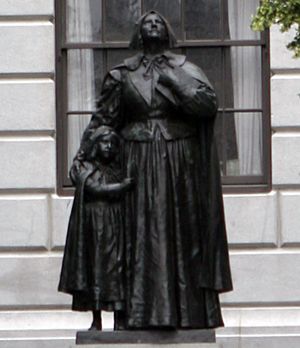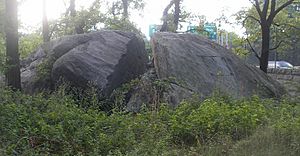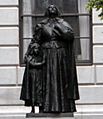Susanna Cole facts for kids
Quick facts for kids
Susanna Cole
|
|
|---|---|

Susanna Cole as a child with her mother, Anne Hutchinson, in a bronze memorial at the Massachusetts State House
|
|
| Born | baptized 15 November 1633 Alford, Lincolnshire, England
|
| Died | by 14 December 1713 |
| Other names | Susanna Hutchinson |
| Occupation | Indian captive during Kieft's War |
| Spouse(s) | John Cole |
| Children | Susanna, Samuel, Mary, John, Anne, John, Hannah, William, Francis, Elizabeth, Elisha |
| Parent(s) | William Hutchinson and Anne (Marbury) Hutchinson |
Susanna Cole (born Hutchinson; 1633 – 1713) was a brave girl who survived a terrible attack by Native Americans. Her famous mother, Anne Hutchinson, and many of her brothers and sisters were killed in this attack. Susanna was taken captive and lived with the Native Americans for a few years before she was set free.
Susanna was born in Alford, England. She was just a baby when her family sailed to New England (now part of the USA) in 1634. When she was almost five, her family moved to Aquidneck Island (now Rhode Island). They had to move because her mother, Anne Hutchinson, was asked to leave Massachusetts due to her religious beliefs.
Susanna's father died when she was about eight years old. After that, she, her mother, and six of her siblings moved from Rhode Island to a new area. This place later became part of The Bronx in New York City. Sadly, they were caught in the middle of a conflict called Kieft's War. This war was between the local Siwanoy Native Americans and the Dutch settlers. In August 1643, almost all of Susanna's family was killed in an attack. Susanna was the only one who survived. She was taken captive by the Siwanoy and was returned to the English three years later.
When Susanna was released, she went to Boston to live with her older brother and sister. She got used to English life again and married John Cole when she was 18. John was the son of a well-known innkeeper in Boston. They lived in Boston for a few years. By 1663, they moved to the Narragansett area of Rhode Island. They went there to look after land that belonged to her oldest brother, Edward Hutchinson. Susanna and John stayed there and raised a large family. Susanna Cole was still alive in 1707, but she had passed away by December 1713.
| Top - 0-9 A B C D E F G H I J K L M N O P Q R S T U V W X Y Z |
Susanna's Early Life
Susanna Hutchinson was baptized in Alford, England, on November 15, 1633. She was the youngest child of William and Anne Hutchinson to travel with them to New England in 1634. She was the 14th child born to her parents. Eleven of their children survived to make the trip to the New World. A 15th child was born after they arrived in New England.
Moving to Boston
The family first settled in Boston. They lived across the street from a leader named John Winthrop. He was a judge in a trial in 1637 that led to Susanna's mother being asked to leave the Massachusetts colony. When Susanna was very young, her mother held popular religious discussions at their home. Her mother's religious ideas were different from those of the Puritan ministers. This caused a big disagreement in the Boston church. It made things very difficult for the colony's leaders.
Life in Rhode Island
Because of these problems, the family had to leave Massachusetts. They moved with many of her mother's supporters to Aquidneck Island in Narragansett Bay. There, they started a new settlement called Portsmouth. This settlement soon became part of the Colony of Rhode Island and Providence Plantations. Susanna was less than five years old when her family left Boston. She was about eight when her father died in Portsmouth.
Attack and Captivity
After her father died, Susanna's mother was worried that Massachusetts might try to control Rhode Island. So, she moved to a part of New Netherland that later became The Bronx in New York City. She moved with her six youngest children, an older son, a son-in-law, and some servants.
At that time, the Dutch were fighting the Siwanoy Native Americans in a conflict called Kieft's War. In August 1643, the Siwanoy attacked the Hutchinson family's home. All members of the family were killed, except for nine-year-old Susanna.
There are different stories about how Susanna survived. One story says her red hair saved her from being killed. Another story claims she was picking blueberries away from the house. She then hid in a rock crevice at Split Rock. Whatever happened, the attackers took her captive. She was held by them for several years.

Susanna's Return
John Winthrop, the governor of Massachusetts, wrote about Susanna in his journal in July 1646. He said that Susanna was about eight years old when she was taken. She stayed with the Native Americans for about four years. When she returned, she had forgotten her own language and her family. She was even sad to leave the Native Americans.
However, other sources suggest her captivity lasted less than three years. When she came back to Boston, her living siblings were her oldest brother Edward, her brother Samuel, and her two oldest sisters Faith and Bridget. It is believed that Susanna went to live with her brother Edward and his family in Boston. On December 30, 1651, she married John Cole in Boston. John was the son of Samuel Cole, who had opened Boston's first tavern in 1634.
Susanna's Adult Life
Susanna and John Cole started their family in Boston. But by 1663, they moved to the Narragansett area. This land was disputed at the time, but it later became North Kingstown, Rhode Island. The Coles lived there for the rest of their lives and raised many children.
John Cole's father, Samuel Cole, left property in Boston to Susanna and her children in his will. This was to fulfill an agreement with Susanna's brother Edward and uncle Samuel. This property was rented out in 1676 and sold in 1698 for £160.
In April 1667, John Cole gave their house in Boston to Susanna's brother Edward and uncle Samuel. This showed that they planned to stay in Narragansett. They lived near Wickford. This area was claimed by both Connecticut and Rhode Island. Many people in Wickford preferred to be under Connecticut's rule. John Cole became a local leader and commissioner for the area under Connecticut in the late 1660s.
Eventually, Rhode Island gained control over the Narragansett lands after many years of arguments. John Cole was made a peace officer under the Rhode Island government in 1682. John died by 1707. Susanna and her son William were put in charge of his estate that year. Susanna died by December 14, 1713. Her son William then handled the final matters of his parents' estate.
Family and Legacy
Susanna and John Cole had 11 children: Susanna, Samuel, Mary, John, Ann, a second John, Hannah, William, Francis, Elizabeth, and Elisha. At least nine of them grew up to be adults. Their oldest daughter Susanna married Thomas Eldred. Mary lived into her 60s and never married. Ann married Henry Bull, whose grandfather was Rhode Island colonial governor Henry Bull. A second son named John also grew up. Hannah married Thomas Place, and William married Ann Pinder. Francis also grew up. Elizabeth married Robert Potter, and Elisha married Elizabeth Dexter. Elisha served as a Deputy or Assistant in the Rhode Island colony for many years.
Some of Susanna Cole's well-known descendants include two people who ran for United States President. These are Stephen Arnold Douglas, who lost to Abraham Lincoln in the 1860 election, and Willard Mitt Romney, who lost to Barack Obama in 2012. Her grandson John Cole, the son of Elisha Cole, became a chief justice of the Rhode Island Supreme Court.
Many books and articles have been written about Susanna Cole's famous mother, Anne Hutchinson. Most of these books also mention Susanna. The novel Trouble's Daughter by Katherine Kirkpatrick tells a made-up story about Susanna's life with the Native Americans who captured her. It also includes some of the limited historical facts known about her.
A bronze statue in front of the Massachusetts State House in Boston shows what Susanna Cole might have looked like as a child with her mother, Anne Hutchinson. This statue was dedicated in 1922.
Images for kids



